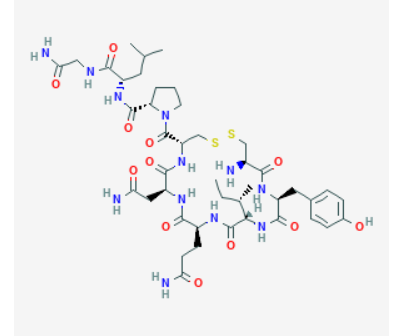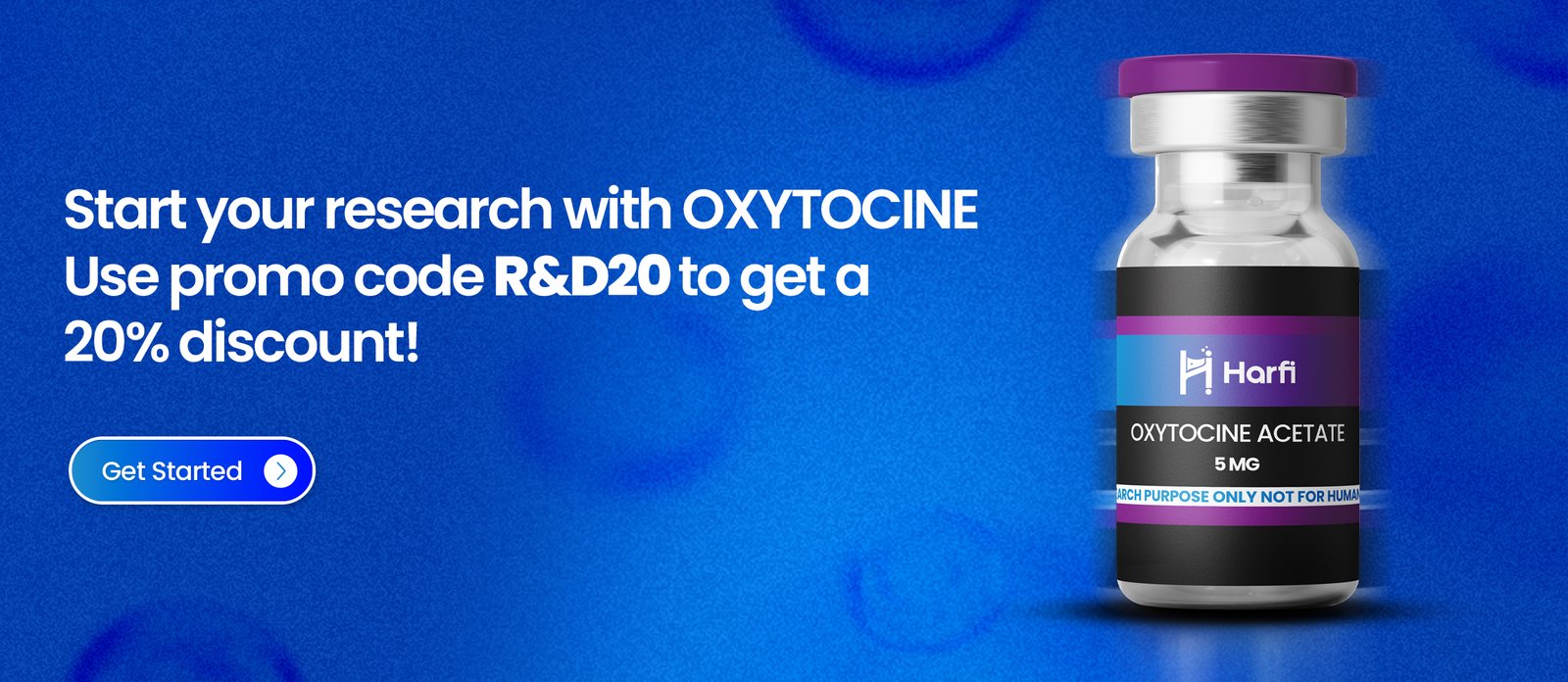Oxytocin
Oxytocin, a naturally occurring protein hormone, plays a vital role in several physiological functions, such as sexual reproduction, childbirth, strengthening the mother-child bond during breastfeeding, and promoting wound healing. Recent research suggests that it may also offer benefits in improving cognitive function, lowering cardiovascular risks, and mitigating the effects of diabetes.
Product Usage
This product is intended for research purposes only. It is strictly designated for in vitro testing and laboratory experimentation. All information provided on this website is for educational purposes only. Any introduction into humans or animals is strictly prohibited by law. Only licensed, qualified professionals should handle this product. It is not a drug, food, or cosmetic and must not be misbranded, misused, or mislabeled as such.
Introduction
Oxytocin is a unique protein with two distinct natural functions. Primarily, it acts as a neuropeptide released by the hypothalamus, playing a key role in bonding, sexual reproduction, and childbirth. Additionally, it functions as a circulating hormone, primarily produced by the placenta in pregnant women, where it influences labor, milk production, and maternal bonding with newborns. In men, the testes produce small amounts of oxytocin, contributing to mating behavior and pair bonding.
Research has revealed oxytocin’s involvement in various physiological and psychological processes, including:
- Facilitating milk ejection and lactation
- Inducing uterine contractions during childbirth
- Regulating blood pressure
- Modifying neuron function
- Strengthening social bonds
- Affecting fear and anxiety responses
- Influencing mood
- Supporting wound healing
Structure
Sequence: Cys-Tyr-Ile-Gln-Asn-Cys-Pro-Leu-Gly
Molecular Formula: C43H66N12O12S2
Molecular Weigh: 1007.193 g/mol
PubChem CID: 439302
CAS Number: 50-56-6
Synonyms: Pitocin, Endopituitrina, Ocytocin

What Is Oxytocin?
Oxytocin is a short peptide composed of nine amino acids. It is initially synthesized in the hypothalamus and later released by the posterior pituitary gland. However, its production is not limited to these organs; it is also found in the placenta, ovaries, and testes. Like many peptide hormones, oxytocin originates from a larger precursor molecule that undergoes cleavage to become its active form. Interestingly, oxytocin has also been detected in other body tissues, such as the retina, adrenal glands, thymus, and pancreas. Traditionally classified as a neurohypophysial hormone, ongoing research suggests that oxytocin plays a broader role beyond the nervous system.
Oxytocin Research
Oxytocin’s Role in Wound Healing
Often recognized for its role in social bonding, oxytocin also influences inflammation by regulating specific inflammatory cytokines. A study involving 37 couples demonstrated a fascinating link between social interactions and wound healing. Higher oxytocin levels correlated with faster wound healing. Notably, couples who experienced hostile interactions exhibited a 40% reduction in healing rates. Additionally, these couples showed lower levels of key inflammatory markers, such as IL-6, tumor necrosis factor-alpha, and IL-1beta, at the wound site.
Oxytocin and Cardiovascular Health
Given its ability to regulate inflammation and promote healing, researchers have explored oxytocin’s potential benefits in cardiovascular health. Studies suggest that oxytocin can reduce fat mass, improve glucose tolerance, lower blood pressure, and decrease anxiety—factors that significantly impact cardiovascular disease (CVD).
Research indicates that atherosclerosis, a leading cause of CVD, may result from reduced oxytocin receptor expression. Increasing oxytocin levels in individuals with diminished receptor density has been linked to maintaining cardiovascular integrity and, in some cases, even reversing atherosclerosis.
Animal studies have further demonstrated oxytocin’s protective effects on heart health. In rats, direct oxytocin infusion during ischemic events (such as a heart attack) helped protect heart muscle cells from damage. Additionally, prolonged oxytocin treatment appeared to prevent dilated cardiomyopathy and enhance cardiac stem cell function, aiding in tissue regeneration.
Studies in diabetic mice also highlighted oxytocin’s role in mitigating heart damage. Treatment led to a 19% reduction in body fat and a 23% decrease in fasting glucose levels, primarily due to improved insulin sensitivity. As a result, these mice exhibited reduced heart muscle hypertrophy, fibrosis, and cell death.
Beyond the heart, oxytocin’s protective effects extend to other tissues. Research on priapism (persistent erection) in rats suggests that oxytocin may help prevent ischemia-reperfusion injury by modulating nitric oxide levels.
Oxytocin and Diabetes Management
Oxytocin appears to enhance glucose uptake in skeletal muscles by improving insulin sensitivity, making it a promising candidate for diabetes management. Studies in mice have demonstrated that oxytocin facilitates lipid metabolism, reducing body fat and the risk of dyslipidemia. Interestingly, oxytocin deficiency has been linked to obesity, even in individuals maintaining normal food intake and exercise, underscoring its role in energy balance.
Research comparing lean and obese mice showed that oxytocin treatment had a significant impact on glucose regulation and body composition in obese mice, whereas it had little to no effect on lean mice. This suggests that oxytocin’s benefits in diabetes management may depend on metabolic conditions.
A clinical study on diabetic patients found that intranasal oxytocin reduced glucose and insulin levels while promoting significant weight loss—patients lost an average of 9 kg over eight weeks. Additionally, individuals with type 2 diabetes had lower circulating oxytocin levels, which were negatively correlated with glycosylated hemoglobin A1C and insulin resistance.
Oxytocin and Cognitive Function
Research has long suggested that early maternal deprivation can lead to lasting cognitive and behavioral changes. Studies in mice indicate that these effects may be partially attributed to oxytocin fluctuations resulting from reduced parental bonding. In one experiment, maternally deprived mice treated with oxytocin showed improved hormone levels linked to neuron development in the prefrontal cortex. While no significant behavioral changes were noted, there was a trend toward better cognitive performance in the oxytocin-treated group.
Additional studies have demonstrated that intranasal oxytocin enhances learning, particularly in stressful environments, highlighting its potential role in cognitive development.
Oxytocin’s Role in Anxiety and Depression
A growing body of research has linked oxytocin to mental health conditions such as anxiety and depression. Variations in the oxytocin receptor gene have been associated with social anxiety disorder and attachment difficulties in childhood. Additionally, individuals with untreated social anxiety exhibit epigenetic changes in the oxytocin receptor gene, suggesting that low oxytocin levels may contribute to these disorders.
Oxytocin and Borderline Personality Disorder (BPD)
Borderline Personality Disorder (BPD), a severe form of social anxiety, has recently been linked to oxytocin dysregulation. BPD is characterized by heightened threat perception, deep mistrust, and altered non-verbal communication. Intranasal oxytocin treatment has shown promise in modifying these behaviors, offering new insights into potential therapeutic approaches for BPD.
Oxytocin’s Role in Hunger Regulation
Studies on Prader-Willi syndrome, a condition marked by an uncontrollable appetite, suggest that excessive suppression of oxytocin signaling may contribute to its development. This indicates that oxytocin may play a role in hunger regulation and feeding behavior.
Oxytocin’s Impact on Aging Muscles
Recent research has identified oxytocin as a critical factor in maintaining and repairing muscle tissue. Studies at Berkeley found that declining oxytocin levels with age reduce the number of oxytocin receptors on muscle stem cells. Administering oxytocin reversed this effect, allowing aging muscles to recover much of their healing capacity. This discovery suggests that oxytocin could play a vital role in addressing age-related muscle loss (sarcopenia) and organ deterioration.
DISCLAIMER: FOR INFORMATIONAL AND EDUCATIONAL PURPOSES ONLY
All articles and product details provided on this website are strictly for informational and educational purposes.
The product information presented here applies solely to in-vitro studies—experiments conducted outside of living organisms, such as in laboratory settings. These products are not classified as medicines or drugs and have not been approved by the FDA for the prevention, treatment, or cure of any medical conditions, ailments, or diseases.

